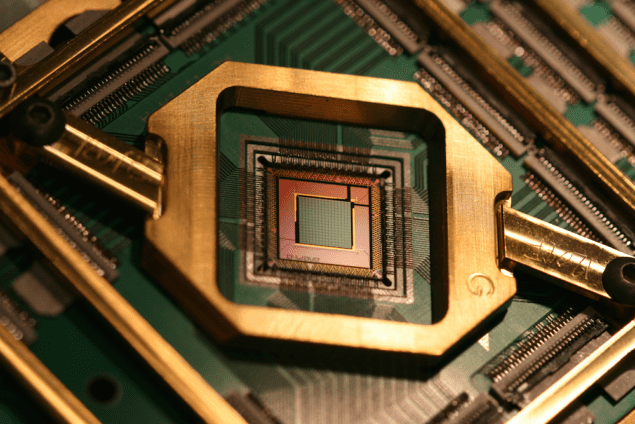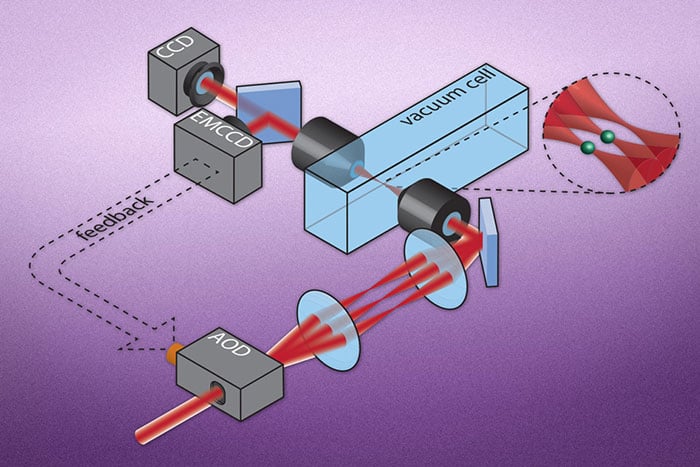
Researchers in Canada have used a D-Wave quantum processing unit to solve a computationally challenging problem in condensed matter physics. While the speed of the calculation does not surpass that of the best conventional computers, the work could be a major step towards the use of quantum processors to enhance physicists’ understanding of systems that are currently difficult to compute. Some experts, however, say that the technique has significant limitations.
The team focussed on the transverse field Ising model, which is a stalwart of condensed-matter theory. It is used, for example, to describe magnetic materials by assuming that spin magnetic moments are fixed on a regular lattice and interact with their nearest neighbours in the presence of an applied magnetic field.
Other systems outside condensed matter physics can also be described by the same equations. Quantum computing expert Helmut Katzgraber of Texas A&M University in the US offers an example: “Suppose you have a very large museum such as the Louvre in Paris and you want to place guards in the museum. You want to find the smallest number of guards that you can distribute across the museum such that every single room is watched.”
In 1D, the model’s equations can be solved analytically. In two or more dimensions, however, numerical solutions are required. On a conventional computer, a lot of computing power is needed to run the necessary algorithms: “The workhorse for studying that system is something referred to as quantum Monte Carlo,” explains condensed matter physicist Richard Harris of D-Wave Systems. “People use very large servers to study that particular system using that technique.”
Quantum annealing
To try to devise a more effective simulation, Harris and colleagues at D-Wave, Simon Fraser University and the University of British Columbia used a commercial D-Wave processor. This is a cryogenic chip containing several thousand interacting superconducting loops, with each loop acting as a quantum bit (qubit). The researchers programmed the qubits to simulate a cubic lattice of 8x8x8 individual spins. In a process known as quantum annealing, the system evolves by quantum tunnelling from a superposition of all possible states into the lowest energy state. The researchers looked at the effect of flipping or removing individual spins on the other spins in the lattice to calculate values for some important magnetic properties. These results were in good agreement with those found in literature.
The team went on to find magnetic phase transitions in the lattice. The transverse field Ising model can produce various magnetic configurations. In the paramagnetic state, the spins are aligned. In the antiferromagnetic state, neighbouring spins point in opposite directions. In the spin glass state, the spins adopt a seemingly random orientation. Which state the system adopts depends on the values of temperature, applied field and the amount of disorder in the lattice (caused, for example, by impurities).
Choose your sequence of programs, put them in overnight and your results are there in the morning
Richard Harris
“If you were a condensed matter physicist doing these sorts of experiments, you’d have to produce an entire series of crystals where you’d very carefully changed the concentration of impurity or disorder and take measurements on each individual crystal.” explains Harris. “We’re showing here that you can move along all three axes on our processor by programming: choose your sequence of programs, put them in overnight and your results are there in the morning.”
Harris admits that the results from their D-Wave simulations are not yet competitive with state-of-the-art conventional computers: “We are working at the level of an early- to mid-1990s, high-horsepower computer, not a modern mainframe computer,” he explains. “Nevertheless, we’re actually starting to see a place where you can push the limits of modern digital computing.”
Very significant
Katzgraber, who was not involved in the research, is more cautious. “The approach that they have used, while it works very well for a magnetic system, will not be extended easily to many other problems. ” Nevertheless, he describes the paper as “very significant” for its fulfilment of Richard Feynman’s dream of a machine that could use a quantum approach to simulate the physics of a material successfully.

Quantum simulators shed new light on magnetic phase transitions
Quantum computing expert Barry Sanders of University of Calgary in Canada agrees with Katzgraber on the significance of the work. He is sceptical, however, of Harris’ claim that the D-Wave offers any potential to overtake classical computing: “If you use a multi-core processor with enough cores, you can do the same thing with quantum Monte Carlo on a classical computer as with D-Wave,” he explains. “As the problem gets bigger, you need a bigger D-Wave computer – and the scaling factor is the same with the classical computer as with D-Wave.”
The research is described in Science.



